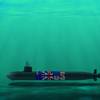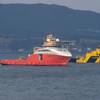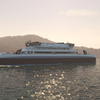The first of two coastal protection vessels has been delivered to Spain’s Maritime Safety Authority SASEMAR. The main role for 220-ton bollard pull Don Inda is emergency towing of a tanker, as it is equipped with a full range of equipment for recovering spilled oil. Rolls-Royce developed the UT 722 L design -- derived from the anchor handler of the same type number, although they differ from an offshore AHTS in many respects -- and provided the main equipment. Astilleros Zamakona, based at Santurce-Bilbao, built the vessels.
The SASEMAR vessels have a large installed power and very powerful towing winches, but are flexible enough to take on many other roles including pollution clean-up, escort towing, rescue of ships and their crews, emergency co-ordination, firefighting and salvage.
Don Inda is 80 m long, with a beam of 18 m and a draft of up to 6.8 m. Hull depth to main deck is 8.25 m, considerably larger than the normal UT 722 L.
An important feature is the large tank capacity for recovered oil of approximately 1,730 cu. m. The installation of an oil/water separation system is designed to enhance this capacity further. The recovered oil tanks will be filled with about 95 percent oil and five percent water, the separator discharging water of a cleanliness meeting environmental regulations back to the sea, whereas normally oilrec tanks would contain a mixture of about 50/50 oil and water. Because the recovered oil may have a high viscosity, the tanks are heated, enabling oil to subsequently be pumped to another vessel or ashore. This feature means that the SASEMAR vessels can act as pumping stations in the event of a massive oil spill.
Four Bergen eight cylinder B32:40 long stroke engines power the vessel, producing a total of 16,000 kW. Two engines are coupled to each propeller shaft turning a CP propeller, and a fire pump is geared to the forward end of the inner engine of each pair. This propulsion system provides a maximum speed of 17.6 knots and a bollard pull of about 220 tons. Depending on the operating mode, either all four engines can be run, or just one on each shaft line. In addition, there are powerful auxiliary generator sets, and the swing-up azimuth bow thruster has its own independent 736kW diesel engine. Maneuvering is enhanced by high lift rudders, twin stern tunnel thrusters and an additional bow tunnel thruster supplementing the azimuth unit. The vessels are being built to Bureau Veritas Class and have dynamic positioning notation AM/ATR, which corresponds to IMO DP2 standard.
The towing winch on Don Inda is designed to use the full bollard pull capability. This main winch is a two drum hydraulic Rauma Brattvaag unit sized for 83 mm wire and capable of pulling 300 tons with a 550 ton brake holding load. For escort work there is a winch on the foredeck with a 45 ton pull/250 ton brake load equipped with synthetic rope towlines. A strongly fendered reinforced bow allows the SASEMAR vessels to push disabled ships. Deck layout aft is designed to give a clear lead for towlines, but the vessels will be prepared for an A-frame at the stern which can be put aboard when required, for example to undertake salvage of sunken vessels.
Subscribe for
Maritime Reporter E-News
Maritime Reporter E-News is the maritime industry's largest circulation and most authoritative ENews Service, delivered to your Email five times per week










